Ijraset Journal For Research in Applied Science and Engineering Technology
- Home / Ijraset
- On This Page
- Abstract
- Introduction
- Conclusion
- References
- Copyright
Green Audit in Nanasaheb Mahadik College of Engineering, Peth
Authors: Harshad Bhosale, Ashwini Lohar , Samrudhi Shete , Prasad Kamble
DOI Link: https://doi.org/10.22214/ijraset.2023.54095
Certificate: View Certificate
Abstract
A clean and healthy environment aids effective learning and provides a conducive learning environment. There are various efforts around the world to address environmental education issues. Environmental Management Systems (EMS) is very popular in the industrial sector, but the general belief is that EMS is something pertaining to industries only. Other parts of the world have started adopting compatible environmental management systems either voluntarily or by promoting standards by external certification. International environmental standards do not suit the existing Indian educational system. A very simple indigenized system has been devised to monitor the environmental performance of educational institutions. Reduction in resource uses Financial savings through a reduction in resource use Curriculum enrichment through practical experience Development of ownership, personal and social responsibility for the college and its environment Enhancement of college profile Developing an environmental ethic and value systems in young people.
Introduction
I. INTRODUCTION
A. General
The research mainly focuses on finding out the best alternative systems for the treatment of wastewater which gives feasibility for a small population. The proposed research includes the development of cost-effective alternatives for project execution. Also, Numerous research papers were selected to study the best system for contaminants removal. From the research, the objective function of the model, and input parameters used in research were studied. Some research was also performed on suggesting the best alternative for wastewater treatment using various modifications.
B. Relevance
Educational institutions have broad impacts on the world around them, both negative and positive. The activities pursued by campus can create a variety of adverse environmental impacts. But they are also in a unique position as educational institutions to be leaders in pursuing environmentally sustainable solutions.
Green Audit is a process of systematic identification, quantification, recording, reporting, and analysis of components of Floral and Faunal diversity within the campus. It aims to analyze green practices within and outside of the concerned sites, which will have an impact on the eco-friendly ambiance. Shri Venkateshwara Shikshan Sanstha started Nanasaheb Mahadik College of Engineering in the year 2011.
The institute is approved by the All India Council for Technical Education (AICTE), New Delhi, and affiliated with Dr. Babasaheb Ambedkar Technological University, Lonere. The integrated campus is situated on Pune-Bangalore National Highway (NH4) at Peth Naka. We have focused on certain indicators, covering an extremely wide range of environmental impacts. For each indicator, we establish to evaluate University's overall performance. We examine the performance of universities on each of these indicators and offer recommendations about how the campus can reduce its environmental impact within each indicator. We hope that the time-to-time Green Audit will provide an accurate snapshot of the University's environmental impact at this point in time and that it will aid the campus in prioritizing positive steps it can take to improve overall sustainability. We intend this document to be revisited annually and updated by the University.
C. Outline of Project Report
The project report is structured into different chapters, each covering specific aspects of the study. The outline of the project report is as follows:
This dissertation report is divided into 6 chapters which describe the different investigations conducted in this study
- Chapter 1: Introduction This chapter provides an overview of Green Audit. It presents a general introduction to college information on the topic. Methodology and Research Progress This chapter describes the methodology adopted for the study and provides an update on the progress of the project work.
- Chapter 2: Literature Review and Objectives In this chapter, previous studies conducted by researchers in the field are reviewed. The motivation behind the study and the objectives of the project work is also explained.
- Chapter 3: analytical Green Audit are systematic identification, quantification, recording, reporting, and analysis of components of environmental diversity.
- Chapter 4: Experimental work about Audit stage; water audit- The water mainly used for the purposes in the collage, Observations, Water Quality Assessment, Water Management, Recommendations; Green audit- Objectives of the policy, Observations, Plantation, Routine green practices, Future plan, Recommendations
- Chapter 5: Conclusion and Future Research In this chapter, the conclusion of the project work is provided, along with suggestions for further research. The report also includes a discussion chapter and a concluding chapter. The Civil Engineering Department is responsible for the construction and implementation of the project.
II. LITERATURE SURVEY
-
Jeff Sturman Goen Ho Kuruvilla Mathew(2004), “ Water auditing and Water Conservation; Policy and governance, Wastewater, reuse and sludge, Water resources/environment”
Water auditing is a method of quantifying water flows and quality in simple or complex systems, with a view to reducing water usage and often saving money on otherwise unnecessary water use. There is an increasing awareness around the globe of the centrality of water to our lives. This awareness crosses political and social boundaries. In many places people have difficult access to drinking water. Often it is polluted. Water auditing is a mechanism for conserving water, which will grow in significance in the future as the demand for water increases.
2. Sylvia Van Leeuwen.(2004): “ Development in Environmental auditing by supreme audit institutions”
At the end of the 1980s, Supreme Audit Institutions (SAIs) became aware of their responsibility towards the environment and environmental policy. In this article, the development of environmental auditing by SAls during the last 10 years is presented, as well as the current state of the art. The description is based on the results of three questionnaire surveys held in 1994, 1997, and 2000 by the INTOSAI Working Group in Environmental Auditing. In most countries, the government has stipulated some form of environmental policy, and the SAI has a mandate to carry out regularity and/or performance audits. The activities of SAIs have developed substantially since 1993. Nowadays, environmental auditing is a substantial and regular part of the audit work of more than half of the SAIs. Environmental problems are often transboundary in nature. SAls can contribute to international environmental cooperation by auditing the compliance of their national government with international environmental obligations and commitments
III. OBJECTIVE
The proposed work has the following objective
- To identify the areas of green audit and water audit.
- To study the existing scenario of green auditing considering the limitations of an existing system.
- To assess the quality of the water and study of the Green part in the NMCOE, Peth college campus. (College building, Library, Canteen,Workshop, Ground, Girls hostel, Boys hostel)
- To implement a green audit system on a college campus.
IV. RESEARCH METHODOLOGY
A. Methodology
The methodology adopted to conduct the Green Audit of the Institution had the following components. The purpose of the audit was to ensure that the practices followed on the campus are in accordance with the Green Policy adopted by the institution. The criteria, methods, and recommendations used in the audit are based on the identified risks. The methodology includes preparation and filling up of a questionnaire, physical inspection of the campus, observation, and review of the document, interviewing responsible persons, and data analysis, measurements, and recommendations. The methodology adopted for this audit was a three-step process comprising of
B. Data Collection
In the preliminary data collection phase, exhaustive data collection was performed using different tools such as observation, survey communication with responsible persons, and measurements.
The following steps were taken for data collection:
The team went to each department, Library, canteen, and Hostel.
Data about the general information was collected by observation and interview.
C. Data Analysis
All these papers majorly discuss green audits for an institutional campus in terms of Waste Management
- Establishing a baseline of existing environmental conditions with a focus on the natural and physical environment.
- Understanding the current practices of sustainability with regard to the use of water and green, generation of wastes, purchase of goods, transportation, etc.
- Awareness generation among students concerning real issues and their sustainability.
- To provide strategies and action plans towards improving green audits for future
D. Recommendation
On the basis of the results of data analysis and observations, some steps for water consumption were recommended. Proper treatments for waste were also suggested. The use of fossil fuels has to be reduced for the sake of community health. The above target areas particular to the college were evaluated through a questionnaire circulated among the students for data collection.
V. DATA COLLECTION
A. Water Audit
The purpose of this program is to identify cost-effective water-saving measures and encourage conservation among those users and assist them in implementing the savings measures recommended. In the water audit the sources of water, Water distribution system. water use and water disposal are carefully studied and water wastage is encountered.
This indicator addresses water consumption, water sources, irrigation, stormwater, appliances, and fixtures. A water audit is an on-site survey and assessment to determine the water use and hence improve the efficiency of its use.
1. Water use
This indicator addresses water consumption, water sources, irrigation, stormwater, appliances, and fixtures. A water audit is an on-site survey and assessment to determine the water use and hence improve the efficiency of its use.
Table5.1 The student and faculty strength of the college is listed below:
|
No of students |
950 |
|
No of teachers |
70 |
|
No of Non-teaching staff |
30 |
|
Total |
1050 |
|
Departments |
7 |
|
Laboratories |
25 |
|
Conference halls |
1 |
|
Libraries |
1 |
|
Auditorium |
1 |
|
Canteens |
1 |
2. Physical Structure
The college is located on about 11.32 acres of land. The spacious campus contains the main building, hostels for boys and girls, and workshop with a built-up area of around 10000sq.m.
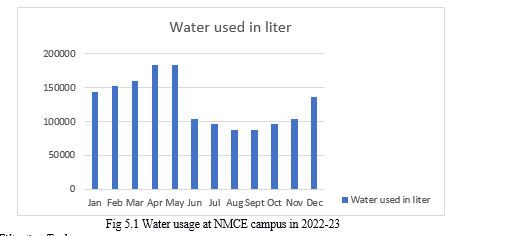
3. Waste Water Filtration Tank
The university has a huge campus with its administrative setup and there is a lot of wastewaters collected from laboratories and other open areas which is disposed of in the tank. University has constructed a Mini Water Filtration Tank on the campus. This filter house is used to filter wastewater regularly. This water is utilized for further trees and plants on the university campus as self-filtered water throughout the year.
a. Water Storage and Distribution
- The water from these sources is then stored in roof PVC storage tanks. From these storages, the water is then distributed to various user points.
b. Waste Water Management
- The total wastewater generated on the campus is approximately 28000 lit/day.
- The wastewater from the administrative building is discharged in to soak pit within the campus. Some water is discharged outside the campus.
- Waste Water from the boy's hostel is discharged out of campus. Wastewater from the girl's hostel is used for irrigation purposes without any treatment.
- Waste water from the canteen is discharged outside the campus.
c. Rain Water Harvesting
- Presently rainwater harvesting project is under installation for the canteen building.
- Design details are as follows.
- Roof area covered- sqm Avg yearly rainwater collection expected, considering avg. rainfall of 810 mm, is 1,35,000 liters.
Table 5.2 wastewater characteristics
|
Characteristics |
Value |
|
PH |
8.1 |
|
Total dissolved solids |
2230 ppm |
|
Total suspended solids |
800 ppm |
|
Chemical oxygen demand |
480 ppm |
|
Biological oxygen demand |
128 ppm |
|
Dissolved oxygen |
7.12 ppm |
B. Green Audit
This includes the plants, greenery, and sustainability of the campus to ensure that the buildings conform to green standards. This also helps in ensuring that the Environmental Policy is enacted, enforced, and reviewed using various environmental awareness programs.
The excessive environmental degradation is creating "Environmental poverty". Thus, academic leaders should initiate the knowledge and benefits of resources so that their institutions respond to environmental issues and challenges. We believe that there is an urgent need to address these problems and reverse the trends of environmental degradation.
Plantation
Total number of plant species identified 11
Total number of plants on the campus 212
Table 5.3 List of plants on the college campus
|
Sr.No. |
Name of trees (English Name) |
Scientific Name
|
No of trees |
|
1 |
Mango |
Mangifera Indica |
130 |
|
2 |
Coconut |
Cocus Nucifera |
25 |
|
3 |
Flowers trees |
Clade Angiospermae |
40 |
|
4 |
Shevari |
Sesbania Sesban |
18 |
|
5 |
Peepal |
Ficus Religiosa |
8 |
|
6 |
Guava |
Psidium |
4 |
|
7 |
Ashoka |
Saraca Asoca |
15 |
|
8 |
Cinnamon |
True Cinnamon |
3 |
|
9 |
Chiku |
Manikara Zapota |
1 |
|
10 |
Chafa |
Frangipani |
6 |
|
11 |
Floral species |
|
101 |
|
12 |
Other trees |
|
72 |
|
13 |
Height of the plant |
|
(3 to20 ft) |
|
|
TOTAL |
|
423 |
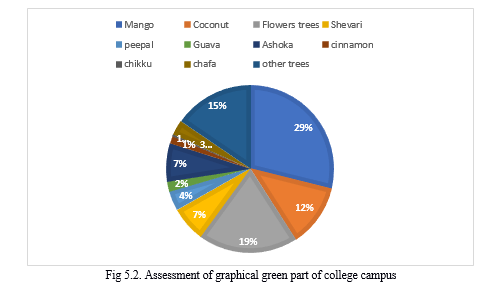
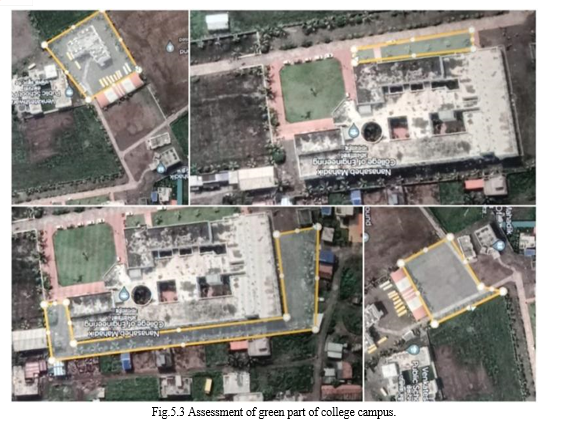
VI. EXPERIMENTAL WORK
A. Study Area
The selected site is situated are Shri Venkateshwara Shikshan Sanstha Nanasaheb Mahadik College of Engineering, Peth,Tal: Walwa, Dis: Sangli 415407. The college is located on about 11.32 acres of land. The spacious campus contains a main building, hostels for boys and girls, workshop with a built-up area of around 10000sq.m.
Green audit forms part of a resource management process. Although they are individual events, the real value of green audits is the fact that they are carried out, at defined intervals, and their results can illustrate improvement or change over time. Eco-campus concept mainly focuses on the efficient use of energy and water; minimizing waste generation or pollution and also economic efficiency.
B. To study basic green audit
This requires data collection and efforts for clarification of environmental policies. Green auditing includes systematic identification, recording, and analysis of components related to the sustainable development of an educational institution to preserve for future generations. The process has three important stages such as pre-audit stage, audit stage, and post-audit stage.
C. To study of Water audit in NMCOE
Water is a natural resource; all living organisms depend on water. While freely available in many natural environments, in human settlements potable (drinkable) water is less readily available. Groundwater depletion and water contamination are taking place at an alarming rate. Hence it is essential to examine the quality and usage of water in the college. Water auditing is conducted for the evaluation of facilities of raw water intake and determining the facilities for water treatment and reuse.
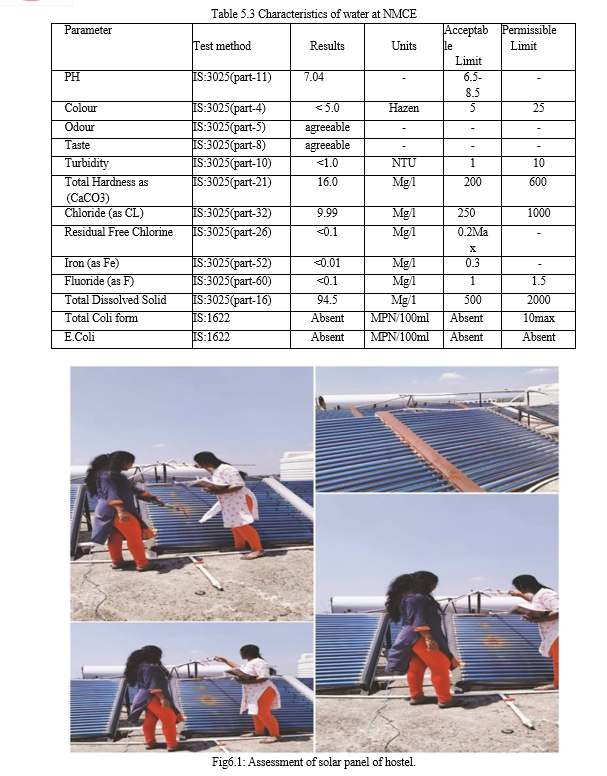
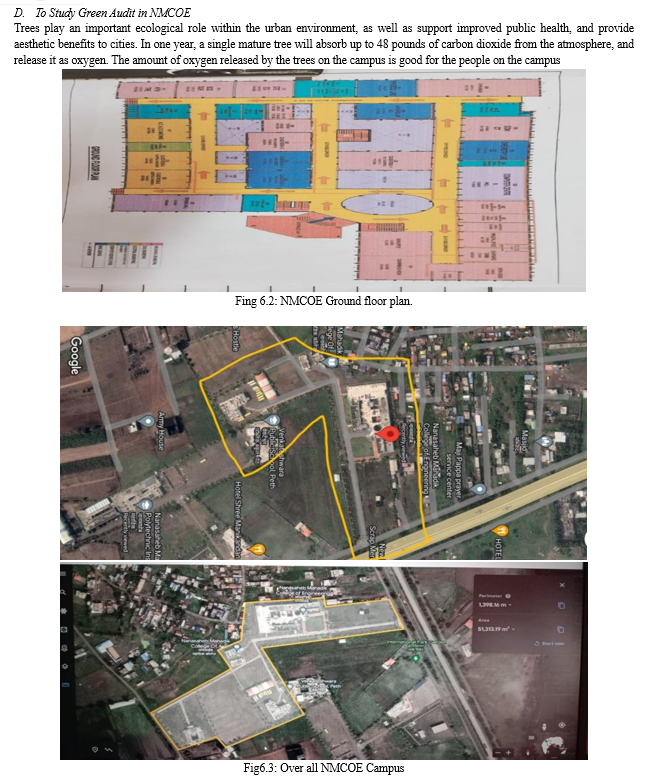

VII. FUTURE SCOPE
The future scope of construction wetland systems is promising, as they continue to gain recognition and importance in various fields. Here are some potential areas where wetland systems can play a significant role:
A. Recommendations are Water Audit
- On campus small-scale/medium-scale/large-scale reuse and recycling of the water system is necessary.
- Minimize wastage of water and use of electricity during the water filtration process, if used, such as the RO filtration process, and ensure that the equipment used for such usage is regularly serviced.
- Ensure that all cleaning products used by college staff have a minimal detrimental impact on the environment, i.e. they are biodegradable and non-toxic, even where this exceeds the Control of Substances Hazardous to Hea(COSHH) regulatiGreen Future plan:-
a. Improve the greenery by up to 50% by plantation like trees and medicinal plants on the campus.
b. Plantation of water harvesting plants.
c. Eco-friendly management.
d. Development of medicinal garden.
e. Organic farming for the support of nature and the environment.
f. Development of pollution-free zone.
g. Awareness of cleanliness and maintenance of flora and fauna.
B. Recommendations Green Audit
Review periodically the list of trees planted in the garden, allot numbers to the trees, and keep records. Assign scientific names to the trees.
Promote environmental awareness as a part of coursework in various curricular areas, independent research projects, and community service.
Create awareness of environmental sustainability and take action to ensure environmental sustainability.
Establish a College Environmental Committee that will hold responsibility for the enactment, enforcement, and review of the Environmental Policy. The Environmental Committee shall be the source of advice and guidance to staff and students on how to implement this Policy.
Conclusion
Green Audit is one of the important tools to check the balance of natural resources and their judicial use. Green auditing is the process of identifying and determining whether institutional practices are eco-friendly and sustainable. It is a process of regular identification, quantification, documenting, reporting, and monitoring of environmentally important components in a specified area. The main objective to carry out a green audit is to check the green practices followed by the university and to conduct a well-defined audit report to understand whether the university is on track for sustainable development. After completing the audit procedure of the university for green practices, there are the following conclusions, recommendations, and Environmental Management Plan(EMP) Which can be followed by the university in the future for keeping the campus environment friendly. 1) To comply with all applicable and regulatory requirements for the protection of the environment 2) As part of a green audit of campus, we carried out the environmental monitoring of campus including Illumination and Ventilation of the classroom. It was observed that Illumination and Ventilation are adequate considering natural light. 3) Toilets and bathrooms are consuming more water in the departments. The replacement of old taps can be beneficial for solving this issue 4) To induct a sound environmental management system and practice it in all our academic and nonacademic activities. 5) This environmental policy is a reflection of our National commitment towards environmental protection for more safe and healthy working
References
[1] M.Villar, E.Dominguez, F.Tack, J.Ruiz, and R.Morales, \"Vertical subsurface wetlands for wastewater purification,\" rocedia Engineering, vol. 42, pp. 1960- 1968, 2012. [2] S.Lu, L.Pei,, and X.Bai, \"Study on method of domestic wastewater treat- ment through new-type multi-layer artificial wetland,\" international journal of hydrogen energy, vol. 40, no. 34. pp. 11207-11214, 2015. [3] M.Solano, P.Soriano, and M.Ciria, \"Constructed wetlands as a sustainable solution for wastewater treatment in small villages,\" Biosystems Engineering. vol. 87, no. 1, pp. 109-118, 2004. [4] V.Vipat, U.Singh, and S.Billore, \"Efficacy of rootzone technology for treat- ment of domestic wastewater: Field scale study of a pilot project in bhopal.(mp), india..\" The 12th World Lake Conference, vol. 1, pp. 995-113, 2008. [5] Application of modified root zone treatment system for wastewater treat- ment within nallah area Journal of Ecology and Environmental Sciences, vol. 3, pp. 1-9, 2012. [6] Y. Patil and G. Munavalli, \"Performance evaluation of an integrated on- site greywater treatment system in a tropical region,\" Ecological engineering, vol. 95, pp. 492-500, 2016. [7] S.Shinde and S.Phad, \"Low cost sewage treatment by root zone technology,\" International Journal of latest trends in Engineering. Science, Humanities and Management, vol. 978, pp. 44-51, 2017. [8] S.Kouki, F.Mihiri, N.Saidi, S.Belaid, and A.Hassen, \"Performances of a con- structed wetland treating domestic wastewaters during a macrophytes lifecy- cle.\" Desalination, vol. 246, no. 1-3, pp. 452-467, 2009. [9] G.Gholikandi, M.Moradhasseli, and R.Riahi, \"Treatment of domestic wastew- ater in a pilot-scale hsfew in west iran,\" Desalination,, vol. 248, no. 1-3. pp. 977-987, 2009. [10] G.Munavalli, P.Sonavane, S.Wandare, G.Deshpande, and N.Aswale, “Effect of media and vegetation in constructed wetland for domestic wastewater treatment,” Journal of Applied Science and Computations, vol. 5, pp. 8–13, 2018.
Copyright
Copyright © 2023 Harshad Bhosale, Ashwini Lohar , Samrudhi Shete , Prasad Kamble . This is an open access article distributed under the Creative Commons Attribution License, which permits unrestricted use, distribution, and reproduction in any medium, provided the original work is properly cited.

Download Paper
Paper Id : IJRASET54095
Publish Date : 2023-06-15
ISSN : 2321-9653
Publisher Name : IJRASET
DOI Link : Click Here
 Submit Paper Online
Submit Paper Online

